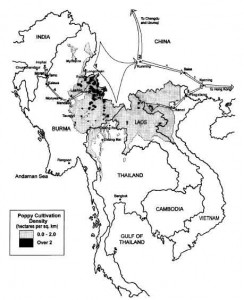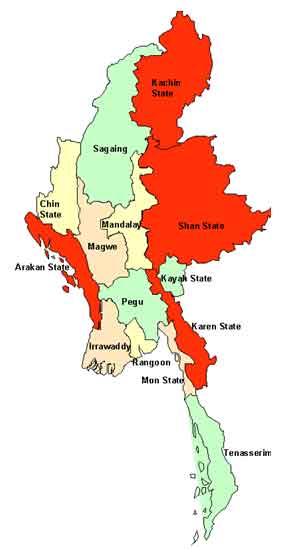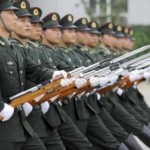Ethnic minorities constitute almost one-third of the total population; the minority communities are located mainly in seven states, and these are named after these communities. The following map1 shows the divisions and states.
Ethnic Minority Communities in Myanmar
- Shah
- Kayah
- Karen
- Mon
- Chin
- Kachin
- Rakhine
Insurgency in Myanmar is the result of the ongoing tension among the ethnic communities of the country. Reasons for the same date back to 1948, when Myanmar received its independence and the constitution formed was around the Buddhist communities, ignoring the existence of other minority groups, which led to discontentment among the minority groups and the subsequent armed rebellion, which with time organised itself into a full-fledged insurgency. As a result, most of the country has become a conflict zone and most of Myanmar’s territory lies ungoverned, which is a perfect sanctuary for organised crime to sustain itself.
The impact of the insurgency is no longer a local one. It has for long started affecting its neighbours, and with passing time, the impact is quite visible globally.
In 1989, an agreement of ceasefire was signed between the insurgent groups and the Junta-led army, which stabilised the conflict areas and restored peace and calm in the conflict zones. But in 1996, the ceasefire arrangement broke down and a major offensive against the Karen National Progressive Party (KNNP) was launched by the military leadership, resulting in the destabilisation of the region and eruption of large-scale insurgency and violence.
The impact of the insurgency is no longer a local one. It has for long started affecting its neighbours, and with passing time, the impact is quite visible globally. The existence of ungoverned areas in the conflict zones and increasing demand for money to run the insurgency movement has led to the establishment of organised narcotics trade, with Myanmar being the production and processing hub of heroin. Since the beginning of the global war on terrorism, a lot of Western attention has come to the area, but lack of insight regarding the geopolitical realities of the area has led to countries picking sides, and this has made it more difficult for the policymakers to come up with a solution of the problem.
Insurgency in Myanmar has existed since 1948, and the nature of the warfare in the region is modernised and the insurgent groups are using sophisticated weapons and battle gear. This has led to a dependence on large amounts of money, which is generally earned through indulgence in organised crimes. Major sources of income for these groups are:
- Narcotics trade
- Gun-running nexus
- Smuggling of contraband products to neighbouring countries
- Human trafficking
- Extortions
At present, Myanmar accounts for almost 90 per cent of world’s heroin production.
Narcotics Trade2
Myanmar falls in the area of the Golden Triangle of Southeast Asia, which geographically includes northern Thailand and northern and western Laos. These places are the centre of poppy cultivation area since the early nineteenth century. In the last 15 to 20 years, the production of poppy in Thailand has gone down because of the drastic eradication and crop substitution measures taken by the Thai government. As a result, the production of poppy in Myanmar has increased, making it the world’s largest producer of poppy. In 1988, when the political turmoil took place, the government lost control over a lot of its area, and subsequent battles between the rebels and the army made it a safe haven for the narcotics trade to flourish. At present, Myanmar accounts for almost 90 per cent of world’s heroin production. Burmese poppy cultivation has traditionally been limited to several remote mountainous regions in the country’s north and east; the major areas include the Kokang hills of Shan state, the Eastern Shan hills, the Wa hill area and the Kachin state. These areas are all border zones, with extensive land borders with northern Thailand, Laos and China’s Yunnan province. Opium grown in these extensively cultivated areas is refined into heroin in a network of small concealed (and relatively mobile) factories scattered throughout the hills. The purest heroin (Number 4) is a white crystalline powder of high grade and is the major export form of the drug. Number 4 is manufactured principally to be injected, although it can be smoked as well.
Since 1987, Myanmar has been classified by the United Nations as a least developed nation and remains one of the world’s poorest countries. Its per capita income was US$220 per year in 1995. Heroin exports are a significant mainstay of the Burmese economy, although economic data on the narcotics industry is sparse.
Narcotics Smuggling Routes
 Eastern Myanmar to Yunnan Province, China
Eastern Myanmar to Yunnan Province, China
Myanmar shares a long, mountainous border with the Chinese province of Yunnan. The principal route for heroin trafficking into China is from the Burmese Wa and ethnic Shan areas across into Yunnan by road to the capital, Kunming, and then by air or road to Baise, Nanning, Hong Kong and on to the west.
Eastern Myanmar to Northwestern China
A second route for Burmese heroin also begins in eastern Myanmar, leads to Kunming city in Yunnan and then goes north and west, through Chengdu, the capital of Sichuan province, across western China to Urumqi in Xinjiang province and then across the Chinese border to Kazakhstan.
Myanmar/Laos to Northern Vietnam and into Southern China
A third route for heroin trafficking into China is a southern route from Myanmar and Laos across the Laos-Vietnam border to northern Vietnam and then into China through the China-Vietnam border zone of Pingxiang City, Guangxi province. It is not known whether this route involves only Laotian or both Laotian and Burmese heroin. Laos has several poppy-growing areas, one of which, the region of Xiang Khoang, borders both Vietnam and China Pingxiang and has had a recent and rapid outbreak of heroin availability since 1997–1998.
Manipur appears to have no significant indigenous tradition of opium poppy cultivation. Local officials and drug users are consistent in reporting that heroin from Myanmar…
Western Myanmar to Manipur State, Northeast India
Manipur is a small landlocked state in the northeast of India. Its borders include the Indian states of Nagaland to the north, Assam to the west, Mizoram to the south and a 358 km border with Myanmar to the east. The Burmese border includes the large Sagaing Division and a section of the northern Chin Hills. Manipur is one of the poorest and least developed regions in India, with a 1996 per capita income estimated at 3,500 rupees per year, about one third of the Indian national average. Manipur has been governed under Indian security laws since the 1950s and is currently patrolled by Indian army and four other paramilitary forces, in addition to two Manipuri security agencies. The political situation is complex, with a large and longstanding insurgency seeking autonomy, many smaller ethnic insurgencies, numerous armed groups and several thousand political and economic migrants and refugees from Myanmar. A state of low-intensity chronic civil war pervades, and armed clashes, human rights abuses and violence are endemic.
Manipur appears to have no significant indigenous tradition of opium poppy cultivation. Local officials and drug users are consistent in reporting that heroin from Myanmar, called locally Number 4, began to appear in Manipur in 1982–1984. After 1984, the availability and use of heroin increased steadily, reaching epidemic proportions after 1990. Although precise numbers of addicts are difficult to assess, a 1991 estimate was 15,000 injection drug users (IDUs); it is clear that heroin use is common and has been attributed to widespread availability of Burmese exports. From Manipur, it is transported to Cox Bazaar, a port city in the neighbouring country of Bangladesh using the inland water ways where it hits the international water.
Gunrunning Nexus
Narcotics trafficking and arms trafficking are closely related. Narcotics products are generally the mode of payment for these insurgent groups for the purchase of small arms and its ammunition. Rise in the narcotics trade and gunrunning was seen after 1989, when the Communist Party of Myanmar fell and lots of its cadres started depending on the illicit drug trade to keep matters going.
The gunrunning or the trafficking routes are same as that for opium smuggling. The only difference is that the movement is inside. Small arms include a variety of products, ranging from automatic weapons to Chinese-made hand grenades and landmines.
Most of the weaponry that flows into Myanmar and the Northeast finds its way from Cambodia, which had surplus during the Pol Pot days.
The use of narcotics trade has also impacted the modus operandi of the insurgents in northeastern India. Earlier, insurgent groups like the United Liberation Front of Assam (ULFA), the National Socialist Council of Nagaland–Isaac Muivah (NSCN-IM), the United National Liberation Front (UNLF) and the People’s Liberation Army (PLA) depended on looting banks and extortions from tea gardens and oil refineries. Large amounts of money also came from kidnappings. Almost no opium trade existed in areas of rebellion, but by 1989, all major insurgent groups had started resorting to drug trade to finance their activities of terrorism.
Most of the weaponry that flows into Myanmar and the Northeast finds its way from Cambodia, which had surplus during the Pol Pot days. It is also reported that most of the arms cartel sourced there weapons from erstwhile East Block countries. The route to south Asia begins in the Rangong Islands, off the Thai coast, from where contraband is shipped through Andaman Sea and lands in Cox Bazaar, from where the arms are carried in smaller caches to different destinations in Myanmar and northeast India. Some of the arms are taken to Chittagong Hill Tracts, from where they enter the northeast region via Mizoram, Tripura or further up, through the North Cachar Hills and Karbi Anglong into Nagaland. Arms are carried even further up, to Sylhet, and enter Meghalaya through Dawki and Baghmara, from where they pass into Assam through Mankachar, in Assam’s Dhubri district, and then through Siliguri and Dooars into Bhutan.
Drug trafficking, which goes hand in hand with the gunrunning business, is generally carried on by the leaders of the liberation armies like the Karen National Progressive Party (KNPP). Arms, along with contraband commodities like MIFL, are the mode of payment, which is received in lieu of drugs, which in turn is used to fight against the army in Myanmar.





